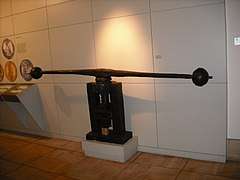Museo Casa de la Moneda (Madrid)
| Museo Casa de la Moneda | |
 | |
 Location in Spain | |
| Established | 1867 |
|---|---|
| Location |
Calle del Doctor Esquerdo Nº 36 Community of Madrid |
| Coordinates | 40°25′22″N 3°40′09″W / 40.422861°N 3.669044°W |
| Collection size | Coins, banknotes, medals, lottery tickets, postage stamps |
| Website | Official website |
The Museum of the Royal Mint (Museo Casa de la Moneda) is a permanent exhibition for the Spanish Royal Mint in Madrid, Spain, begun in 1867.[1]
History
The origins of the museum date back to the eighteenth century and are closely linked to the figure of Tomás Francisco Prieto, General Engraver of the Mint of King Carlos III. Prieto was Director of Engraving at the Royal Academy of Fine Arts of San Fernando and founder, in 1771, of a School of Engraving in which gathered the artists who were later to work at the Royal Mint of Spain and its colonies.[1]
The initial nucleus of the museum was a collection of drawings, engravings, old books, coins and medals made by Prieto to aid in the teaching of his pupils. It was purchased by King Carlos III, and after his death in 1783, was successively added to by acquisitions and donations.
The original collection of the Casa de la Moneda Museum was first exhibited to the public during the reign of Queen Isabel II, in 1867 in the former Casa de la Moneda building on Plaza de Colón in Madrid. It remained there until 1964, when it moved to the present location at Calle Doctor Esquerdo Nº 36.[1]
La Fábrica Nacional de Moneda y Timbre (FNMT, the National Coin and Stamp Factory) was founded in 1893 with the merger of two separate organizations: the Mint and the Stamp Factory. Since 1861 both institutions had shared the same building at Plaza de Colón, although they were independent and had separate administrations.[2]
Exhibits

The Casa de la Moneda Museum is considered one of the most important museums in the world of its kind. The richness of its collections, its extensive facilities and the technical support its staff provides to researchers and teachers, make the museum a unique place.
The numismatic collection includes a history of the coin from its origins, passing through the coinage of Greek and Roman, and important examples such as coins minted in Syracuse, Athens and Aegina. There are some first issues of the Roman Republic. It has a notable collection of Hispanic currency, with items coming mostly from the collection of Gómez Moreno.[1]
See also
References
- 1 2 3 4 "Historia del Museo - FNMT". www.museocasadelamoneda.es (in Spanish). Retrieved 30 July 2017.
- ↑ "Fábrica Nacional de Moneda y Timbre. Real Casa de la Moneda - FNMT". www.fnmt.es (in Spanish). Retrieved 30 July 2017.